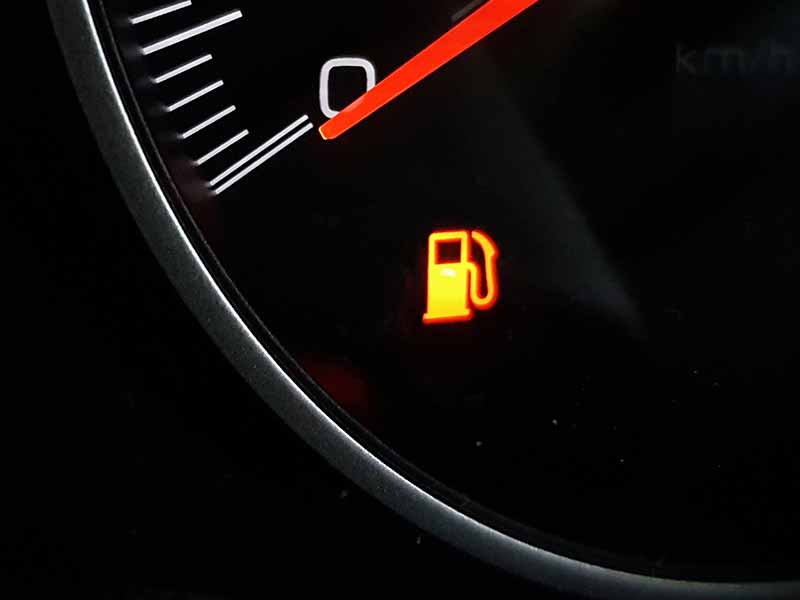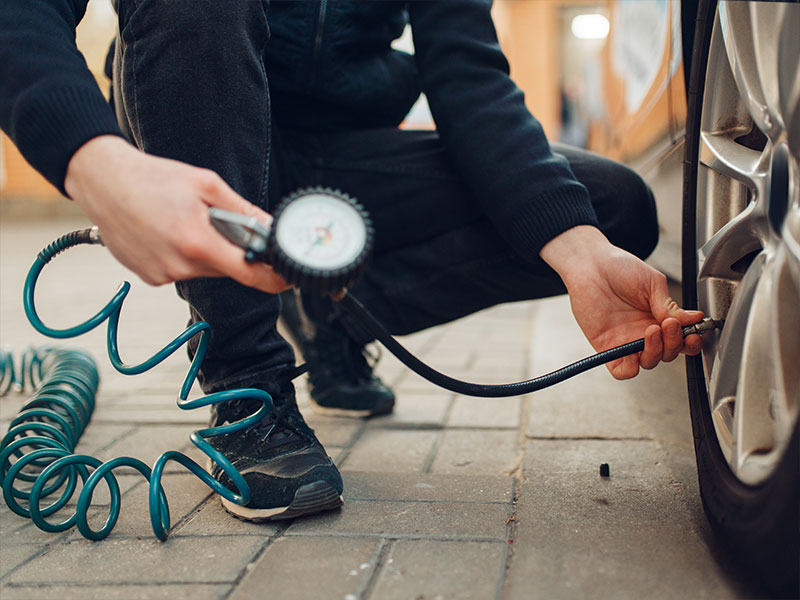Ever noticed how a hot summer day can make a balloon expand or shrink a bag of chips? Much like those objects, your car’s tires also respond to summer’s sizzle. But unlike a balloon or bag of chips, your tires’ reaction to heat can significantly impact your vehicle’s safety and performance.
What Should Your Tire Pressure Be In The Summer?
In the summer, maintain your vehicle’s recommended tire pressure, usually found in the owner’s manual or on a label inside the driver’s door. Regularly check and adjust the pressure as needed to account for the heat’s impact.
In this article, we’ll dive deep into the science of tire pressure, explore how temperature changes affect it, and provide essential tips to maintain the optimal tire pressure during the hot summer months.
We’ll help you understand why tire pressure matters, what it should be in hot weather, why it might seem lower in summer, and how your driving can influence it. Buckle up and let’s get rolling!
Let’s take a closer look.
Understanding Tire Pressure and Its Importance
First, let’s clarify what we mean by ‘tire pressure.’ Simply put, tire pressure is the amount of air inside your tire. We measure it in ‘pounds per square inch’ or PSI. Just like a basketball or a bicycle tire needs the right amount of air to function well, your car or truck tires also need the correct air pressure to do their job effectively.
Why Is Tire Pressure Important?
There are a few key reasons why maintaining the right tire pressure is vital:
- Safety: A tire with the correct amount of air can grip the road better. This gives you more control over your vehicle, making it safer to drive. On the other hand, tires that are underinflated (too low) or overinflated (too high) can make your vehicle hard to handle and more likely to have a blowout.
- Performance: Tires with the proper pressure perform better and respond quicker. This makes turning, accelerating, and stopping much smoother.
- Fuel Efficiency: If your tires are underinflated, your vehicle’s engine has to work harder to move the car, which can use more gas. Properly inflated tires can improve your fuel economy by up to 3%!
- Tire Life: Tires with the right pressure will wear evenly and last longer. Incorrect pressure can cause your tires to wear out quicker, meaning you’ll need to replace them more often (which can be pretty pricey).

The Effect of Temperature on Tire Pressure
Remember back in your science class when you learned about how air expands when it’s heated and contracts when it’s cooled? That principle is at play in your tires too.
- In Warm Temperatures: As the temperature rises, the air inside your tires can expand. This can cause the pressure inside your tires to increase. Sometimes, this might make your tires slightly overinflated.
- In Cool Temperatures: On the flip side, when the temperature drops, the air inside your tires can contract, reducing the tire pressure. In the colder months, you might find your tires slightly underinflated.
But wait a minute, we’re talking about summer, right? So, why are your tires showing low pressure? That brings us to our next point.
Why Can Tire Pressure Be Lower in Summer?
It’s not the summer heat that causes your tire pressure to be low. Rather, it’s usually the comparison to the colder months that makes it seem like your tire pressure is low in the summer.
Here’s why:
Imagine it’s winter, and you’ve filled your tires to the perfect pressure. Then, spring and summer roll around, bringing warmer temperatures. You might think that this would increase your tire pressure, right? Not exactly.
When you filled your tires in the winter, the cold air inside them was denser. As that air warms up in the spring and summer, it expands, but it doesn’t become denser. So, even though the volume of air inside the tire has increased, it may not be enough to compensate for the greater space it takes up inside the tire. As a result, your tire pressure may read lower than expected.
In summary, while hot weather can technically cause an increase in tire pressure, it may seem lower in the summer months because of the denser, cold air that was originally inside your tires.

I Recommend Every Keep A Portable Air Compressor In Their Car Or Truck
Ideal Tire Pressure During Summer
Here’s the deal: there’s no ‘one-size-fits-all’ number for tire pressure. The ideal tire pressure varies based on your vehicle’s make and model.
Don’t worry, though. You don’t have to guess what your tire pressure should be! This information is provided by the folks who made your vehicle. You can usually find the recommended tire pressure:
- On a label on the inside edge of the driver’s door or the glove box door
- In the owner’s manual of your vehicle
Remember, this number is the recommended tire pressure under normal conditions, meaning when your tires are cool. As we learned before, driving can heat up your tires, increasing their pressure. So, it’s best to check your tire pressure when your tires are cold, like in the morning before you start driving.
Should You Lower Tire Pressure in Summer?
While it’s true that your tire pressure can increase with the temperature, it doesn’t mean you should underinflate your tires during the summer. Remember, underinflated tires can pose safety risks and reduce your vehicle’s performance.
Instead, it’s best to stick with the recommended tire pressure from your vehicle’s manufacturer, and check your tire pressure regularly. If it gets too high, you can let some air out. If it’s too low, you can add some air in.

How Driving Conditions Influence Tire Pressure in Summer
When you hit the road, your tires start to heat up due to friction – the resistance between your tires and the road. This heat can cause the air inside your tires to expand, leading to an increase in tire pressure.
Think about it this way: If you’ve ever rubbed your hands together really fast, you’ve probably noticed they get warm. That’s friction at work! The same thing happens with your tires when they’re spinning on the road.
The rise in temperature is even more noticeable during the summer months when the hot road surface adds to the heat generated by tire friction. This extra heat can cause your tire pressure to increase even more.
When and How to Check Tire Pressure
Because tire pressure can increase when the tires are hot, it’s best to check tire pressure when the tires are cool. That means, you should ideally check it in the morning before you start driving for the day.
To check your tire pressure, you’ll need a tire pressure gauge. You can find these at most auto parts stores, and they’re pretty easy to use:
- Remove the cap from the tire’s valve stem (that’s the little pin sticking out from your tire).
- Attach the tire pressure gauge to the valve stem. You should hear a short hiss of air – that’s totally normal!
- Read the tire pressure on the gauge.
- Compare it with the recommended tire pressure for your vehicle. Remember, you can find this on a label in your car or in your owner’s manual.
Adjusting Tire Pressure
If your tire pressure is too high, you can let some air out. Simply press on the valve stem carefully until you reach the desired pressure. Be careful not to let out too much air!
If your tire pressure is too low, you’ll need to add some air. Many gas stations have air pumps that you can use, or you can purchase a portable one to keep in your car.

Tips for Maintaining Proper Tire Pressure in Summer
Now that we’ve learned about the importance of tire pressure and how temperature and driving conditions can affect it, let’s talk about how to maintain the right tire pressure during the summer months.
Regularly Check Your Tire Pressure
Like we’ve said before, checking your tire pressure regularly is crucial. It’s especially important during the summer months when heat can cause more fluctuations in tire pressure. Make it a habit to check your tire pressure at least once a month and before long trips.
Use a Reliable Tire Pressure Gauge
When it comes to measuring your tire pressure, using a reliable tire pressure gauge is key. While many cars today have tire pressure monitoring systems, a tire pressure gauge can give you a more accurate reading. Plus, they’re small enough to keep in your glove box or trunk!
Adjust Tire Pressure as Needed
If you find that your tire pressure is too high or too low, be sure to adjust it. Remember, if it’s too high, you can let some air out. If it’s too low, you’ll need to add some air. Stick to the recommended tire pressure for your vehicle for the best performance and safety.
Don’t Forget to Check the Spare Tire
Your spare tire also needs some love! Make sure to check its pressure regularly. After all, there’s nothing worse than getting a flat tire and then finding out your spare is flat too!
Seek Professional Help if Needed
If you’re having persistent issues with tire pressure or if you’re not comfortable checking and adjusting tire pressure yourself, don’t hesitate to seek help from a professional. Many auto repair shops and tire centers offer tire pressure services.
Resources
Below are some links you may find helpful when learning about tires
Final Thoughts
Just like that balloon expanding on a hot summer day, your tires also react to the heat. But instead of just looking funny or popping with a bang, the changes in your tires can have a real impact on how your vehicle performs and how safe it is. That’s why understanding and maintaining the right tire pressure is so crucial, especially in the summer months.
The key takeaway? Treat your tire pressure like the Goldilocks of your vehicle’s maintenance – not too high, not too low, but just right. Stick to your vehicle manufacturer’s recommended tire pressure, check it regularly, and adjust it as needed.
Good luck and happy motoring.





